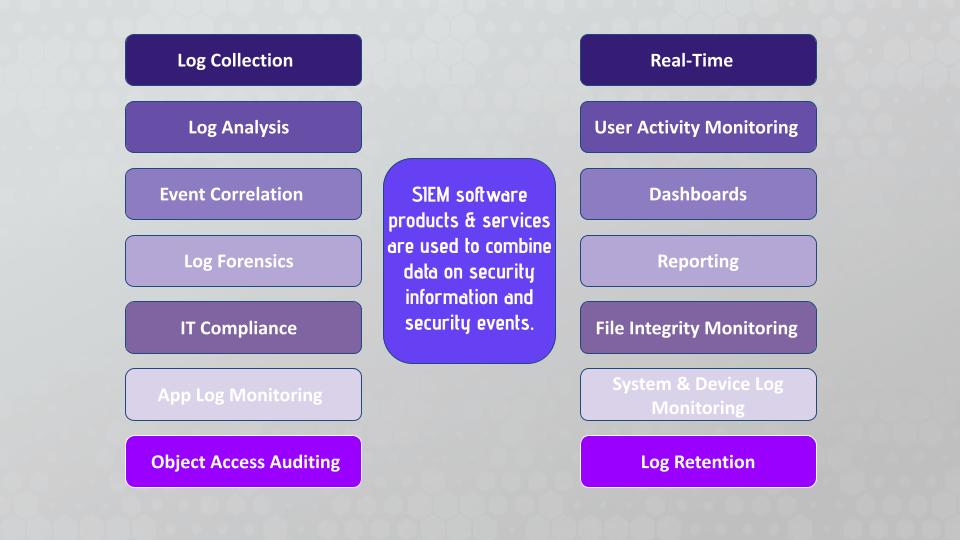What is Security Information and Event Management (SIEM)?
With cyber threats constantly evolving, organizations need robust mechanisms to protect their data and IT infrastructure. Security Information and Event Management (SIEM) has emerged as a critical component of modern cybersecurity strategies. This blog post delves into what SIEM is, its core functionalities, benefits, and why it’s essential for organizations of all sizes.
Understanding SIEM
SIEM is a comprehensive solution that provides real-time analysis of security alerts generated by applications and network hardware. The term SIEM, coined around 2005, combines two essential aspects of security management: Security Information Management (SIM) and Security Event Management (SEM). While SIM focuses on the collection, analysis, and reporting of log data, SEM is concerned with real-time monitoring and incident management. Together, these functionalities enable organizations to identify, investigate, and respond to security threats more efficiently.

6 main functionalities of SIEM
1. Data collection and aggregation
SIEM systems collect data from various sources such as network devices, servers, firewalls, and antivirus software. This data includes logs, events, and other relevant information. By aggregating this data, SIEM provides a centralized view of an organization’s security posture.
2. Normalization
The collected data is often in different formats. SIEM systems normalize this data, converting it into a common format to facilitate easier analysis and correlation.
3. Correlation
One of the most powerful features of SIEM is its ability to correlate data from different sources. By correlating events and logs, SIEM can identify patterns that may indicate a security threat. For example, multiple failed login attempts from different locations within a short period could be flagged as a potential brute-force attack.
4. Real-time monitoring and alerting
SIEM continuously monitors the aggregated data in real-time. When it detects suspicious activities or anomalies, it generates alerts for the security team. These alerts are often prioritized based on the severity of the threat, enabling teams to respond promptly to the most critical issues.
5. Incident response
Beyond just alerting, many SIEM systems have built-in incident response capabilities. This can include automated actions such as blocking IP addresses, isolating compromised systems, or triggering predefined response protocols.
6. Reporting and forensics
SIEM provides detailed reporting capabilities, helping organizations to understand their security posture and comply with regulatory requirements. In the event of a security breach, SIEM’s forensic capabilities allow security teams to conduct thorough investigations by analyzing historical data and identifying the root cause of the incident.
Top 5 benefits of SIEM
1. Enhanced threat detection
SIEM’s ability to correlate data from multiple sources significantly enhances threat detection capabilities. It can identify complex attack patterns that might go unnoticed by traditional security tools.
2. Improved incident response
With real-time alerts and automated response mechanisms, SIEM reduces the time it takes to detect and respond to security incidents. This quick response can mitigate the potential damage caused by cyber threats.
3. Regulatory compliance
Many industries are subject to stringent regulatory requirements regarding data protection and privacy. SIEM helps organizations comply with these regulations by providing detailed logs, reports, and audit trails.
4. Comprehensive visibility
SIEM offers a holistic view of an organization’s IT environment. This comprehensive visibility is crucial for identifying vulnerabilities, understanding the security landscape, and making informed decisions about security investments.
5. Cost efficiency
By centralizing and automating many security processes, SIEM can reduce the need for manual intervention and streamline security operations. This efficiency can lead to cost savings in the long run.
Why SIEM is Essential
As cyber threats become more sophisticated, the need for robust security measures is more critical than ever. Traditional security tools often operate in silos, lacking the integration necessary to detect advanced threats. SIEM bridges this gap by providing a unified platform that collects, analyzes, and responds to security data from across the organization.
Moreover, the increasing reliance on cloud services, remote work, and IoT devices expands the attack surface, making comprehensive security monitoring indispensable. SIEM’s ability to adapt to these evolving environments ensures that organizations can protect their assets, regardless of how their IT landscape changes.
Final thoughts
SIEM is a cornerstone of modern cybersecurity strategies. Its capabilities in data aggregation, correlation, real-time monitoring, and incident response provide organizations with the tools they need to defend against an ever-growing array of cyber threats. By enhancing threat detection, improving incident response, and ensuring regulatory compliance, SIEM systems are not just beneficial but essential for maintaining robust security in today’s digital world. Organizations that invest in SIEM are better equipped to protect their data, maintain trust, and navigate the complexities of the cybersecurity landscape.






